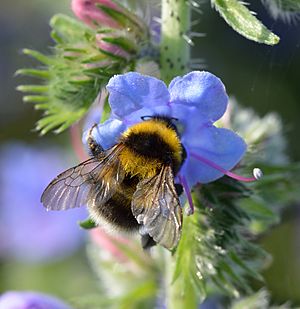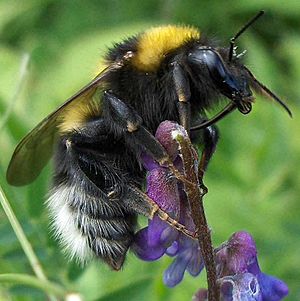Garden bumblebee facts for kids
Bombus hortorum, also known as the garden bumblebee, is a type of bumblebee. You can find these bees in most of Europe, reaching as far north as 70°N. They also live in parts of Asia and New Zealand. What makes them special is their very long tongue. They use this tongue to reach pollen deep inside flowers.
Quick facts for kids Garden bumblebee |
|
|---|---|
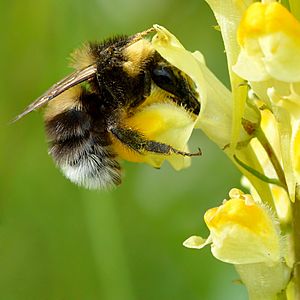 |
|
| Scientific classification | |
| Genus: |
Bombus
|
| Species: |
hortorum
|
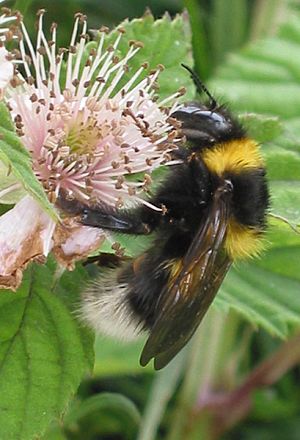
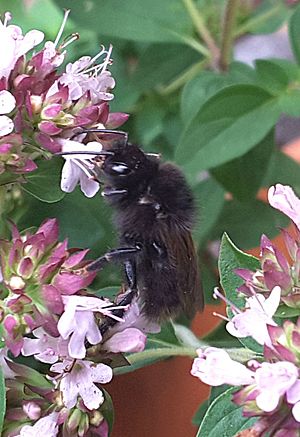
Contents
What is a Garden Bumblebee?
Bombus hortorum belongs to the Bombus family, which includes all bumblebees. It is one of the six most common bumblebees in Europe. Only two of these common species have long tongues: B. hortorum and B. pascuorum.
A close relative is Bombus ruderatus. This bee also has a long tongue. However, it is much less common. Bombus hortorum and Bombus ruderatus look almost the same. But scientists can tell them apart using their DNA.
How Do They Look?
This bumblebee has a long, oval-shaped head. It also has a very long tongue, usually about 15 millimeters (0.6 inches) long. Sometimes, it can be as long as 20 millimeters (0.8 inches)! The tongue is so long that the bee often flies with it sticking out. This happens when it is collecting nectar.
The queen bee can be different sizes. Her body is usually between 19 and 22 millimeters (0.75 to 0.87 inches) long. Her wings can spread from 35 to 38 millimeters (1.4 to 1.5 inches) wide. Worker bees are almost as big as the smaller queens.
Garden bumblebees are mostly black. They have a yellow band around their neck, like a collar. They also have a thin yellow band on their back, near their wings. A third yellow band is found on the first two parts of their belly. Their tail is white. Some garden bumblebees are darker. They have very little yellow fur.
Their Eyes and How They See
Garden bumblebees have two dark, oval-shaped eyes on their head. These are called compound eyes. They can see three main colors: ultraviolet (UV), blue, and green. They are especially good at seeing UV light. This helps them find flowers. Their eyes also help them see polarized light. This is light that vibrates in a specific way.
Where Do They Live?
You can find Bombus hortorum across Europe. They live as far north as Scandinavia. In the west, they reach Iceland, where they were likely brought by people. To the south, they live in parts of Spain and Italy. They are also found in northern Turkey and some Mediterranean islands. However, they are not on Corsica, Sicily, or Sardinia.
They continue across northern and central Asia, through Siberia, and into northern Iran. In 1885, they were brought to New Zealand. They still live there but are not very common. They are also found in America, especially Florida. You can find them throughout the British Isles, including Orkney and Shetland.
Garden bumblebees love to live in grassy areas. These places must have lots of flowers for them to eat from.
How Their Habitat Helps Them
Studies show that B. hortorum are most common in grasslands where cattle have recently grazed. Cattle help the habitat by eating plants. This creates a wider variety of flowers. Bumblebees prefer this diverse environment for finding food.
Because these bees tend to stay in one area, their populations might shrink. This is due to the loss of grassland habitats. To help save Bombus hortorum, it is important to protect large areas with many different flowers. These areas should either be left natural or grazed by cattle. This helps create a good home for the bees.
Where They Build Nests
When queen Bombus hortorum look for a place to build a nest, they often choose edges of forests and fields. They also like open, wild fields. These bees usually build their nests underground. They need moss and dry grass to build their homes. So, they prefer sunny grasslands. This helps keep their underground nests safe and warm. B. hortorum are known for building nests in unusual spots.
Life Cycle of a Colony
How a Colony Grows
A single queen starts a new colony in the spring. B. hortorum queens are usually the last common bumblebee species to wake up after winter. The queen does all the work by herself for over a month. Then, the first group of worker bees grows from larvae.
In late summer and early fall, new queens and male bees are born. The male bees do not return to the nest after they grow up. They live on their own.
The colonies of Bombus hortorum are small compared to other bumblebee colonies. A large bumblebee colony can have hundreds of bees. The bumblebee season usually lasts from mid-March to October. The colony is largest in the summer.
Why Colonies Decline
At the end of the season, in winter, the mated queens look for places to sleep underground. The rest of the colony dies off.
Modern farming uses more pesticides to grow crops. These chemicals can harm Bombus bees. Pesticides can stop B. hortorum colonies from growing. They can also hurt the bees' memory. This makes it hard for them to remember where their food and nests are. When a queen starts her colony, pesticides can affect its growth and size. However, this species is not in danger of disappearing, even with pesticide use.
How They Behave
How They Communicate
Bombus hortorum do not talk much to other bees when they are looking for food. Instead, they find food on their own. They use a method called 'trap-lining'. This means they follow a regular path. They visit the same flowers each time they go out to find food.
Mating Behavior
Female Bombus hortorum mate only once. This makes all the bees in their colony more closely related. At the end of summer, females mate. They then store the male's sperm in a special part of their body. They keep it there during winter sleep. When the queen wakes up in spring to start her colony, she uses this stored sperm to lay eggs. These eggs will become worker bees.
Male garden bumblebees fly along a set path. They mark objects along this path with a special scent called a pheromone. This scent helps attract queens. Charles Darwin even saw this behavior in his own garden in 1886.
How They Find Food
Bombus hortorum bees have been seen feeding on Aquilegia flowers. These include A. vulgaris in Belgium and A. chrysantha in North America. When feeding on Aquilegia flowers, Bombus hortorum do not care about the color of the flowers.
When worker bees go out to find food, they usually collect either pollen or nectar from just one type of plant. Queens, however, collect both pollen and nectar on one trip. They also visit many different types of plants. Queens use their tongue and jaws to hold onto the flower parts and collect food.
Some other bumblebee species make holes in flowers to get food. But Bombus hortorum do not. This is because their very long tongue can easily reach the nectar without needing to make a hole.
Bumblebees often look for food in small areas, just a few square meters wide. They stay in these areas for many days. These small feeding spots are often separated from other areas by bushes.
Studies show that B. hortorum queens and workers prefer Rhinanthus serotinus flowers. These flowers have a long tube shape. The long tongue of B. hortorum can easily reach the nectar inside. When they feed, pollen sticks to their head and chest. This is called nototribic pollination. They can visit about 18 flowers per minute. This is more than other bees. Their long tongues make them very good at collecting pollen quickly. B. hortorum are important for helping different Rhinanthus flowers mix their genes. This leads to new types of plants.
Red Clover
Most of the pollen they collect comes from plants in the Fabaceae family. Bombus hortorum especially love a plant called red clover, Trifolium pratense. They like red clover because its flowers have a deep tube. Their long tongues can easily reach the nectar and pollen inside.
Bumblebees often prefer perennial flowers. These flowers usually make more nectar than annual flowers.
B. hortorum compete for nectar with honeybees. Honeybees sometimes bite holes in red clover flowers. This helps their shorter tongues reach the nectar. But B. hortorum have better eyesight than other bees. This means they can start looking for food earlier in the morning. They can also return to their nests later in the day. This helps them avoid competing directly with honeybees. Bumblebees feed in the morning and evening, while honeybees feed in the afternoon.
B. hortorum also use a special feeding method called buzz pollination. They vibrate their bodies. This makes the flower's pollen shake out. They then collect and eat this pollen. Studies show that B. hortorum create stronger buzzes. This makes them better at collecting pollen.
Traplining
B. hortorum use a behavior called traplining. This means they visit the same feeding areas. They use regular routes that they repeat over several days. Each bee has its own unique route. Using these paths, bumblebees move between groups of plants. They search for pollen and nectar to eat. They usually fly in one direction along these routes. Only strong winds might make them change direction.
How Far They Travel
B. hortorum can fly long distances. They have been known to fly up to 2.5 kilometers (1.5 miles). They can do this in a short time, about one to four days. Queens, especially, travel far when they spread out. This helps mix the genes within the species. When flying long distances, bumblebees sometimes stop to rest. They often rest on tall things in the landscape, like trees.
Unusual Behavior with Trackers
Scientists once attached small radio trackers to the bellies of Bombus hortorum. They wanted to study how far the bees flew. The bees acted strangely because of the extra weight. They took very long breaks to rest and clean themselves. One bee rested for over 45 minutes.
How They Defend Themselves
B. hortorum make loud buzzing sounds to warn others. These are called defensive buzzes. They are much louder and stronger than their normal buzzes. They use them to show they are angry or to scare away threats.
Parasites
A New Parasite
In 1988, scientists found a new sickness affecting B. hortorum workers and queens. It caused strange spores to appear on the bees. Research showed that a new tiny parasite was causing the infection. This parasite is thought to be found across Europe.
Crithidia bombi
Bombus hortorum can also get a common gut parasite called Crithidia bombi. This parasite is found in many bumblebee species. It can harm the queens' ability to have babies. It also affects how well new colonies start after the queens wake up from winter. Queens sleeping underground are not directly harmed by this parasite.
C. bombi usually infects bees when larvae eat the parasite from the worker bees that feed them. This is called vertical transmission. It depends on how many bees can carry the parasite. Bees can also get infected when they pick up the parasite from flowers that other infected bees have visited. This is called horizontal transmission.
Once inside a bee, Crithidia bombi can make copies of itself. The bee's genes can affect how the parasite grows. Bumblebee colonies with less genetic variety (from inbreeding) tend to have more C. bombi. Colonies with more genetic variety are healthier. The bee's genes can also help its body fight off the parasite.
Why Garden Bumblebees Are Important to Humans
Bombus hortorum are very important for pollinating many crops. These include sunflowers, strawberries, apples, and tomatoes.
Modern farming uses more pesticides to grow crops. These chemicals can harm Bombus bees. Bees can get chemicals in two ways. They might eat nectar that has been sprayed with pesticides. Or, they might touch treated plants and flowers. Pesticides can stop B. hortorum colonies from growing. They can also hurt the bees' memory. This makes it hard for them to remember where their food and nests are. When a queen starts her colony, pesticides can affect its growth and size.


